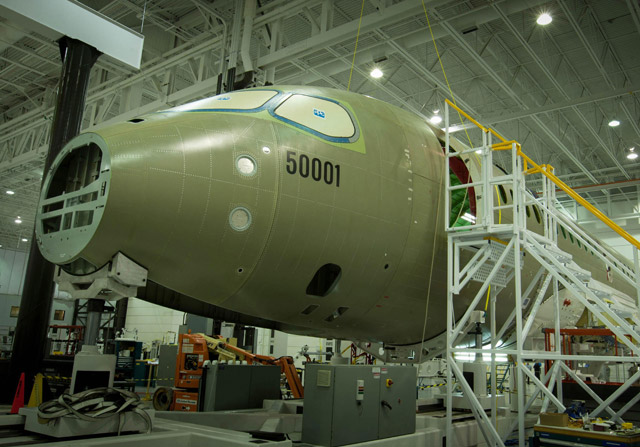Bombardier is still standing by its schedule to achieve first flight of the CSeries aircraft by the end of the year, even as it acknowledges a significant workload remains with less than 12 weeks before 1 January.
The mating of three major sections of the fuselage - forward, centre and rear -- of the first flight test vehicle only serves to underscore the unfinished work ahead.
"There is a lot work to do and the schedule is compressed," says Robert Dewar, Bombardier's programme manager for CSeries. "That's probably the best description of where we are."
Indeed, Bombardier still has to mate the wings, empennage, tail surfaces and landing gear on FTV-1. Meanwhile, the complete airframe static test (CAST) article must be completed and tested to "limit load". The CSeries avionics and systems, including the Parker Aerospace-supplied fly-by-wire, must be certified and installed in FTV-1.
 |
|---|
Bombardier |
Finally, Bombardier has not always achieved first flight with a previously certificated engine, but it intends to do so on the CSeries programme with the Pratt & Whitney PW1500G engine, Dewar says. After installing the engines, the FTV-1 will then have to clear pre-flight gauntlet testing, and low- and high-speed taxi tests before being allowed to fly.
But each of these milestones, Dewar adds, remain on track to be completed sometime this "autumn", a deliberately vague term that technically expires on 20 December.
Bombardier officials have previously acknowledged a minor delay is likely, but Dewar has no intention of relaxing the deadline pressure on his team.
"The schedule is compressed, as you can observe yourself," Dewar says. "But we're not giving up yet. We've been quite successful and the last thing you want to do is take your foot off the gas and let people slow down."
Bombardier is making progress beyond fuselage assembly. Several of the aircraft systems have received safety-of-flight certification, Dewar says, but he declines to elaborate on which ones.
The Parker designed fly-by-wire system, which Embraer two weeks ago described as a "nightmare" to integrate in the Legacy 500, remain a challenge for the CSeries, he says.
"We're working well with Parker. There are a lot of challenges," Dewar says. The fly-by-wire "is one of the most critical packages and it is one of the most compressed schedules."
In July, Parker officials told Flightglobal the fly-by-wire system for CSeries should not cause nearly the same delay as it did for the Legacy 500, which is approaching first flight nearly a year behind schedule.
Source: Air Transport Intelligence news
















